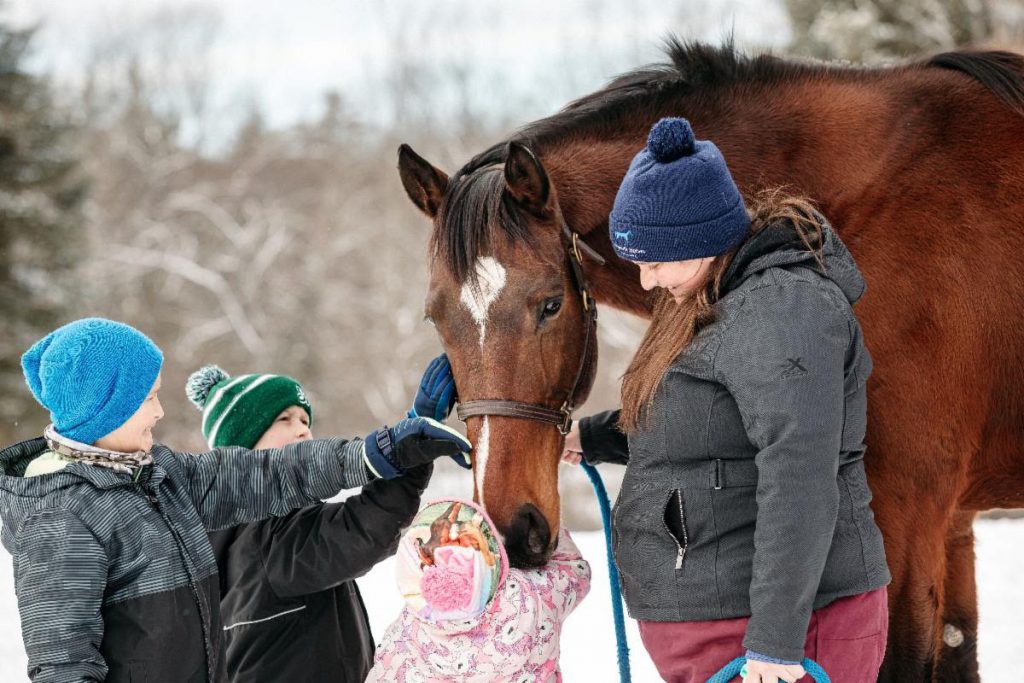
OZONE PARK, N.Y. – In 2014, a bay gelding named Kid Blast created lasting memories for owner Parting Glass Racing, winning or finishing on the board in all eight of his starts at New York Racing Association, Inc. (NYRA) tracks. Now, at the age of 13, Kid Blast is still bringing joy to those around him as a therapy horse just five miles from Saratoga Race Course at Therapeutic Horses of Saratoga.
Trained by Bruce Levine during his racing days, the son of Posse made 26 career starts throughout his five seasons of racing, compiling a record of 5-4-7 with earnings of $151,576. Upon retirement from racing, “Kid”, as he is affectionately known, became a track pony at NYRA, his friendly and easy-going personality making him a good candidate for assisting racehorses on the track.
When a back injury forced his retirement from pony work, Lisa Molloy’s Re-Run Thoroughbred Retirement took in the gelding and provided him with a place to rehabilitate.
Tom Gallo, managing partner of Parting Glass Racing and now Dream Maker Racing, reached out to Therapeutic Horses of Saratoga (THS) after Kid Blast retired from pony work, suggesting the gelding’s experience would allow him to excel as a therapy horse.
“Kid’s personality was just perfect,” said Laura LaRue, the Director of Equine Care at Therapeutic Horses of Saratoga. “We got him in 2019 and he’s got a big brother kind of personality. He flowed right into his role here and just wants to please everyone.”
A Thoroughbred Aftercare Alliance (TAA) accredited not-for-profit organization, Therapeutic Horses of Saratoga was founded in 2018 with the mission of retraining retired thoroughbreds and standardbreds to become therapy horses for clients in partnership with ECS Psychological Services in Saratoga Springs.
Patients are taught equine husbandry at the organization’s Lake Avenue farm, learning to problem solve and work through their emotions.
“Our clients typically spend time getting to know the horses on their first few visits,” LaRue said. “We’ll ask them to catch and bring us a horse from the field and provide them with a halter and lead rope, but most do not know what those are or how to use them. Sometimes they will just entice them over with a piece of hay. This helps our patients learn how to figure things out for themselves and then down the road, we can have them do other things like lead the horses through obstacle courses. The horses challenge them to work through it.”
Kid Blast has proved popular on the farm, a gentle giant who can work in a variety of the program’s activities.
“Kid does everything because he’s amazing,” said LaRue “He’s a very big, stoic and mellow horse and the herd leader in his paddock. Patients will spend time with him and groom him, take him for walks, and go through the obstacle courses. We made this thing we call the car wash. It’s made of pool noodles and the goal is for the clients to guide the horses through it while the noodles brush up against them. Kid Blast has done it a million times and sometimes plants his feet and challenges them to make it through.
“We also have the clients build a corral where they use things like traffic cones and hula hoops to create a pen to lead the horse into,” LaRue added. “There’s a lot of metaphors in it.”
As THS continues to see success in their programs, LaRue credits the emotional capacity of horses as the reason equine therapy can provide another level of support for patients along with traditional therapies.
“The horses are very good at reading emotions and are reactive in a way that is both challenging and comforting,” LaRue said. “They have a very good balance of what the client needs. They can do all this in a way that humans can’t. We are setting the experience up but it’s the horses who are doing all of the mental and emotional work.”
With many success stories to reflect on in the organization’s three years, LaRue fondly recalled her favorite moment shared between Kid Blast and one of their clients.
“We had someone who was saying they were fine when they weren’t, and in therapy it’s kind of hard to turn that off sometimes,” LaRue said. “They were trying to place a halter on another horse and the horse kept walking away. The client was getting frustrated and you could tell that they were feeling like they wanted to give up. Kid walked up from behind and gave them a nudge on their back and placed his face in the halter for them. He reaches out when you need it. He takes good care of everyone.”
Now in his third career, Kid Blast is exemplary of the wide array of new jobs available to racehorses when their days on the track are over. LaRue emphasized that both thoroughbred and standardbred racehorses are favorable to work with in new settings because of how they are handled on the racetrack.
“Racehorses are exposed to things like the starting gate, noise, and crowds and they get used to it pretty quickly,” said LaRue. “Here on the farm, they aren’t nervous around tractors or a tarp flapping around in the breeze. All of their exposure on the track made it a lot easier for them to transition here. It makes a big difference.”
NYRA and its horsemen are committed supporters of the TAA, which accredits, inspects, and awards grants to approved aftercare organizations using industry-wide funding.
Every owner competing at NYRA racetracks donates $10 per start to the TAA, helping to fund aftercare organizations that provide homes for retired racehorses. New York’s horsemen also donate 1.5 percent of the purchase price of every horse claimed at a NYRA track to TAA and the New York
Thoroughbred Horsemen’s Association’s TAKE THE LEAD (TTL) program, which provides preliminary vet exams and treatment, as well as costs related to transportation and rehabilitation or retraining.
“The conversations have grown about aftercare over the last few years which is great,” said LaRue. “NYRA has a day at the races where they bring horses in from the TAA and educate fans to show them options for the racehorses after their careers. It’s really important to continue to have the aftercare conversation and we are excited to be a part of it.”
For more information on Therapeutic Horses of Saratoga, visit https://thsaratoga.org/.
-30-



